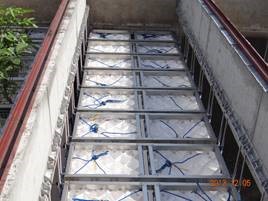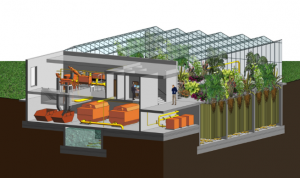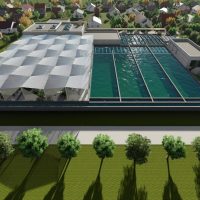Posted on November 3, 2016
As a standard feature of the FCR IFAS solution, the basins can be covered by an attractive enclosure to protect the “botanical garden” on top of the biological reactors providing an odourless solution at the same time. These aesthetic features allow FCR treatment plants to be located in close proximity to residential developments as communities don’t find the facilities objectionable. Therefore the FCR solution is also attractive for recycled water schemes since infrastructure costs are substantially reduced due to relatively short distances between the wastewater source, the treatment plant and the recycled water recipient.
Benefits
The Organica FCR IFAS offers substantially higher economic benefits when compared to other technologies. It can be used for upgrades of existing treatment plants and can also be adopted for new plants.
New treatment plants
When adopted for new installations, the FCR IFAS system requires smaller process volume (ie. lower capital cost, smaller footprint) than an equivalent CAS system due to significant amount of active biomass, in the same physical space, being in a highly concentrated attached form as opposed to much lower biomass concentration in suspended growth.
Additionally, in cases where both a FCR IFAS treatment plant and an equivalent AS treatment plant operate with the same amount of biomass, and clarifier sizing is governed by the thickening criterion, the FCR IFAS plant requires smaller clarification area (ie. lower capital cost) since only suspended portion of biomass is to be settled out. The majority of the biofilm, which does not slough off and stays attached, does not exert any solids loading on the clarifiers.
Upgrade of existing plants
When the treatment capacity of an existing activated sludge plant needs to be increased in order to support higher loadings and/or to meet more stringent effluent quality requirements, the industry practice usually focuses on increasing the bioreactor volume and/or the MLSS concentration to provide the additional bacterial population required to meet the system’s kinetic needs. If the latter option is chosen and the biomass concentration is to be increased, designers often encounter clarifier solids loading limitations that put an upper limit on the amount of biomass that can be carried in the suspended growth system.
FCR IFAS technology provides additional biomass in biological reactors very often without increasing reactor volume. In addition, if the thickening criteria still governs the clarifier sizing, no increase of the clarification capacity is required since most of the biomass is not transferred to the clarifiers. This results in avoided or deferred capital costs which is not possible with conventional activated sludge upgrades.
There are numerous additional advantages of using FCR IFAS solution over other technologies and they are as follows:
- attached and suspended biomass jointly degrade organic pollutants and combined advantages of the two technologies enhance removal of organic matter and nutrients
- fixed biofilm inherently has longer biomass residence time (ie. sludge age) than an equivalent suspended growth biomass due to its nature of being attached to medium. Since significant amount of FCR IFAS biomass is attached, the total sludge age is much longer than in an equivalent AS system
- slow-growing species responsible for nitrification require a long sludge age environment in order not to be wasted faster than they grow and will survive in biofilm attached to plant roots and artificial biotextile medium even at low temperatures. Therefore FCR IFAS systems are able to nitrify at lower temperatures than equivalent conventional suspended growth systems (References 1 and 2)
- high sludge age provides improved stability and robustness of treatment processes including nitrification when compared with an equivalent pure suspended growth system
- added biomass improves performance of nitrifying plants, or even allows non-nitrifying plants to nitrify
- higher level organisms (unicellular cilia, arthropods) have longer life cycles, prefer stable habitat and therefore will establish themselves within the biofilm of FCR IFAS systems. The formation of such a complex ecosystem enables a wider spectrum of organics to be broken down resulting in high quality effluent
- multilevel food-chains, that are present in complex ecosystems, consist of bacteria processing waste material, which are consumed by other organisms, which are in turn prey for higher predators within the food chain. As a final outcome the yield of the biomass, and consequently the amount of the waste sludge is lower
- complex ecosystem, larger biofilm mass and its biological diversity in FCR IFAS make the entire system more stable, very resilient to shock loading and achieve higher degree of nutrient removal when compared to purely suspended growth systems
- any accidental “washouts” of microorganisms is only limited to amount of biomass that is in suspension and therefore processes like nitrification restore faster than in AS systems since a large mass of nitrifiers is retained on the fixed-film
- complex treatment processes take place in biofilm as aerobic, anaerobic and anoxic environments are present in fixed biomass. Simultaneous nitrification denitrification (SND) is one of those processes that readily occur in biofilm and improves nitrogen removal
- high removal efficiency for large range of wastewaters and resistance to organic shock loads
- due to its high biodiversity the system recovers faster than conventional technologies in an event of unsuspected poisoning
- green plants naturally transport oxygen to their roots which increases biofilm activity. They also excrete organic acids on their root surfaces which become food for the biofilm. This is of high importance when the influent load is low. In this case roots help bacteria to survive starvation periods resulting in healthy population of biomass when wastewater load returns to normal. As a result, FCR IFAS systems have greater flexibility and resiliency when compared to conventional activated sludge systems.
So with all the benefits of more biomass per cubic meter, and an even lower footprint compared to the standard FCR system, raises the question of why not use this technology over the conventional FCR everywhere? With all solutions there are drawbacks. Because in the reactor there is additional sludge in a suspended state, the rate of oxygen transfer, or alpha factor is lower, resulting in “thicker” wastewater in the reactors. This leads to more stress on the blowers and thus, increasing OPEX (this OPEX is still way below the expenses of a CAS facility).
With these characteristics in mind, Organica offers specialized solutions for a wider range of situations, by optimizing its design for the given circumstances. Facilities requiring extremely low OPEX can be designed with the standard FCR Solution, while opportunities aiming to maximize the use every cubic inch of reactor volume can get better results with the FCR IFAS Solution.
Examples of operating FCR IFAS technology:
South Pest WWTP – Budapest, Hungary
Foxconn – China
Melbourne Pilot Plant, Melbourne, Australia
References
Biofilm Reactors, WEF Manual of Practice No. 35, WEF Press, 2011
McQuarrie, James P., Boltz, Joshua P., Daigger, Glen T. Interactions between Suspended Biomass and Biofilm in Integrated Fixed-Film Activated Sludge (IFAS) Bioreactors: Process Design Implications for IFAS Systems, WEF/IWA Biofilm Reactor Technology Conference 2010
Fixed Film Activated Sludge, SSWM, http://www.sswm.info/content/fixed-film-activated-sludge




